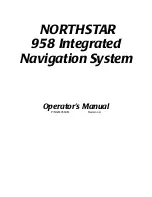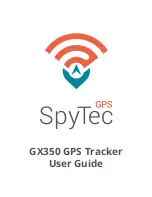
TM106601_(7/01) 2-
5
USE OR DISCLOSURE OF DATA CONTAINED ON THIS PAGE IS SUBJECT TO THE
RESTRICTION ON THE TITLE PAGE OF THIS DOCUMENT
.
C
O M M A N D
S
Y S T E M S
D
I V I S I O N
(d) Waveguide RF Connection
The waveguide input flange, shown oriented to the rear of the antenna housing (Figure 2.9-6,
DA-1203A Antenna Drive Outline Drawing), has a quick-disconnect assembly to facilitate
waveguide connection. The guide pins on the quick-disconnect assembly are offset; assuring that
the waveguide will be connected only in the proper position.
(e) Radome
Refer to Advisory Circular AC No.43-14 in the front portion of this manual.
To allow the most satisfactory radar beam radiation, the nose section in front of the antenna (radome)
should be fabricated for X-band (9375 MHz, 3.2 cm wavelength) signals. A radome having less
than 90% transmisstivity, at all incidence angles defined by the scan and tilt coverage, will result
in some degradation of system performance, and should not be used.
The radome installed should allow the widest possible angle of useful beam radiation (120 degrees,
60 degrees to each side of aircraft heading). Radar range, in terms of that attainable without a
radome, is equal to the square of the radome transmisstivity percentage.
If in doubt of the quality of radome material, a flight test may be performed that evaluates
performance over the anticipated ranges and tilt angles that are desired for the type of aircraft.
2.6.1 Installation of RT-1601 Receiver Transmitter
The receiver-transmitter may be installed in any convenient location within the limits imposed by the
waveguide lengths and environmental criteria. Mounting trays provide for either horizontal or vertical
mount. See Figure 2.9-5, RT-1601 Receiver Transmitter Outline Drawing.
The mounting tray for the receiver-transmitter is designed for front loading. Clean all mounting
surfaces before installing the mounting tray to ensure a good electrical bond to the airframe. See
Figure 2.9-5.
The total mounting space required can be determined from dimensional information contained in the
RT unit outline drawing, Figure 2.9-5. At least three (3) inches of free space must be allowed to the
front left side of the R-T unit's cooling hole areas.
2.6.2 Installation of CP-113 Radar Control Panel
All control panels use DZUS fasteners to secure them to the instrument panel. Use the CP-113
outline drawing, Figure 2.9-7, as a guide to position the control panel and to cut and drill the
instrument panel. Attach the DZUS fastener brackets behind the instrument panel in the location
shown on the CP-113 outline drawing.
The control panel connector assemblies have slide locking lever tabs. To install the connector,
depress the locking lever tab, insert the connector, and release the tab. To remove the connector,
depress the tab and pull the connector out.














































